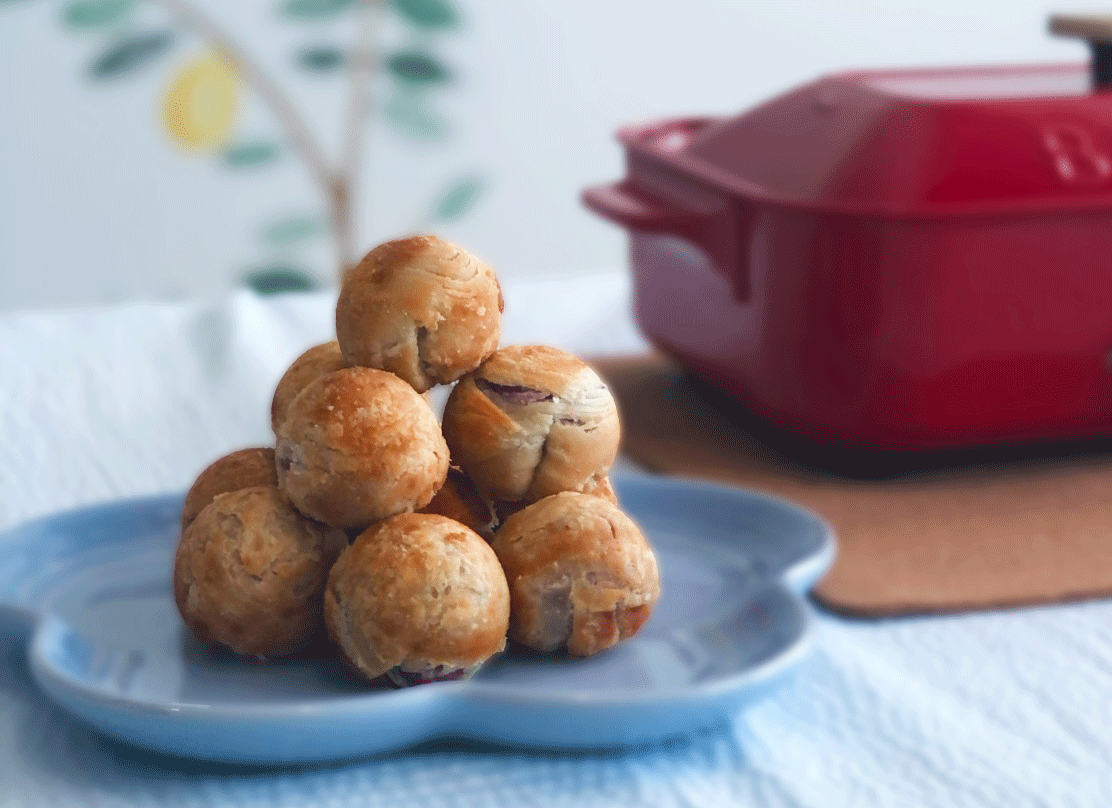Using the craters in its Takoyaki Plate as mini woks to individually shallow-fry these cute taro swirls, your hotplate is uniquely suited to recreate that traditional bakery pastry crispiness, without having to resort to deep-frying.

Delving into the deets
Filling
The bulk of the filling in this Teochew classic is mashed yam/ taro, flavoured with pandan and shallot/ onion oil, our version sees a couple of our own additions:
We added a small proportion of purple sweet potato for a luscious hit of festive colour, however this is optional. Omit this ingredient and replace it with an equal amount of taro for a more traditional mooncake.
A hint of lavender in this recipe was added to imbue a subtle floral perfume to our mooncakes. It’s also a great way to make use of leftover lavender from this soothing lavender soy latte recipe.
Layered Pastry
This traditional "Thousand Layer" Chinese pastry uses two separate doughs, a water dough and an oil dough, which are rolled and laminated together to achieve many delicate and crispy layers.
While this process may seem complicated at first, it’s easy to get the hang of, and the respective doughs have few ingredients and are simple to put together.
They are also stable doughs, not requiring elaborate temperature management or proofing, so it’s a good way for beginner pastry makers to get stuck in.
Fat
The fat we chose to work with for our layered pastry was vegetable shortening, it is easy to work with while kneading and rolling out the dough, and reliably results in a beautifully layered final product.
For more flavor consider switching out a quarter of the vegetable shortening for butter when making the oil dough. However, this mixture will have to be kept cool during the preparation process by chilling it in the refrigerator between each step.
The most traditional choice of fat for this type of pastry, lard, is also a fragrant option. Just replace all the shortening in this recipe with an equal portion of rendered solid lard, and proceed following the same steps.
Recipe (makes 24 Taro Swirls)
Ingredients

Steps
Yam Paste
- Begin by steaming the yam, sweet potatoes, and pandan leaves together in your BRUNO MultiGrill Pot or BRUNO Compact Double Steamer for 30 minutes.
- While the tubers are steaming away, brew up a lavender tea by steeping the lavender flowers in hot water for 20 mins, strain the tea to remove the flowers after steeping.
- After the veggies have steamed till tender, remove the pandan leaves and transfer the tubers to a large mixing bowl. Add the sugar, plain flour, salt, and lavender tea.
- Briefly mash the ingredients together with the back of a large wooden spoon/ spatula. When the mixture is mostly incorporated, further blend them together with a hand mixer for 3 - 5 minutes. When the paste is mostly smooth save for a few small lumps of yam, wrap it in cling wrap and set aside (we liked the home-styled chunky consistency). If a smooth paste is desired for a more traditionally creamy texture, run the mash through a fine-mesh sieve.
- Subsequently, heat the vegetable oil in your MultiGrill Pot or Compact Hotplate's Nabe Pot with the heat set to MED, add sliced shallots/ onions and sauté for 3 minutes to extract its aroma.
- Remove shallots/ onions from the pot with tongs while retaining the oil in it and add the yam paste to the pot and stir it to mix in the onion oil. With the heat still on MED, stir-fry the paste for up to five minutes until it has thickened and turned a shade darker.
- Transfer the cooked yam paste to a container to cool and wrap it with cling film to prevent it from drying out. Store this in the fridge after it has cooled to room temperature.
Oil dough
- With a wooden spoon, mix all the oil dough ingredients together in a large mixing bowl with a spoon until a sandy dough forms. Proceed to knead by hand this dough by hand within the bowl for 2 minutes until the dough is cohesive and all the ingredients are well mixed.
- Wrap the dough in cling film and chill in the fridge.
Water dough
- Likewise, mix all the water dough ingredients together in the mixing bowl to attain a shaggy dough and knead for 5 minutes, the dough is ready when it is sticky and supple.
- Wrap the dough in cling film and chill in the fridge.
Portioning
- Separate the oil dough into 8 equal dough balls weighing about 13.5 g each. Cover these with cling film to prevent them from drying.
- Similarly, split the water dough into 8 dough balls, each of these should weigh approximately 21 g. Cover these when completed too.
- Roll the yam filling into 24 equal-sized yam balls weighing roughly 21 g each.
Assembly
- With your palm, flatten one ball of water dough into a flat disk. Place an oil dough ball in the middle and wrap the water dough around it, pinching to seal the edges. Shape the combined dough into a round ball.
- Use a rolling pin to flatten this amalgamated dough ball and roll it into a thin wide rectangular sheet.
- Starting from the corner, diagonally roll up the dough sheet like a cigar.
- With one of the two cylinder ends facing towards yourself, flatten it once more with the rolling pin, rolling it out long, level, and thin without breaking the dough.
- Sparingly apply water with your fingertip to the top surface of this dough sheet to help it adhere to itself, then roll up the dough down its length once again, the resulting pastry should look like a stowed sleeping bag.

- Repeat the previous steps 1 to 4 to attain eight of these dough rolls.
- With a sharp blade cut each of these dough packages into three equal portions for a total of 24 mini rolls.
- Flatten one of these by turning it cut-side down then gently pushing down on it with the rolling pin and rolling outwards once. Then give the dough a quarter rotation and roll outwards again. Repeat this, rotating and rolling sequence 4 - 6 times till you have a flat and round disk of dough with a spiral of laminated layers.
- Nestle a ball of yam filling into the center of this dough disk and pull the sides of the dough up to envelope the filling. Seal your mooncake by pinching the edges together and apply water with your fingertip to help them stick.

- Set your taro swirl on a tray and cover it with cling wrap to prevent it from drying out.
- Repeat steps 7 to 9 till all the filling has been wrapped and 24 mooncakes are prepared and ready for frying.
Fry them up
- Preheat your BRUNO Hotplate equipped with its Takoyaki Plate to the MED setting. Fill each of the dimples with vegetable oil to roughly a quarter of its depth.
- After the oil has had a chance to heat for a minute, place one taro swirl in each indentation, then immediately reduce the heat to LOW-MED.
- Shallow-fry each surface of the mooncakes for 5 mins, turning each ball periodically with takoyaki picks and frying some more. When the swirls are completely cooked to golden brown perfection (~15 - 20 minutes total), gently scoop them out of the hotplate onto awaiting china. Serve them up while still warm and preferably accompanied by good tea. Enjoy~
